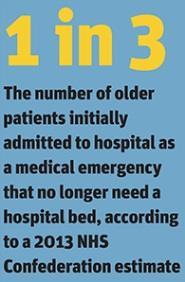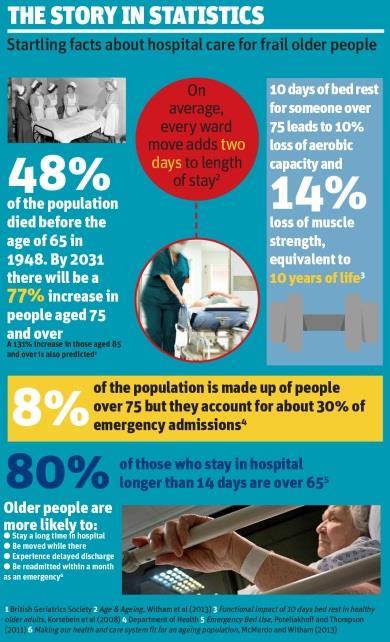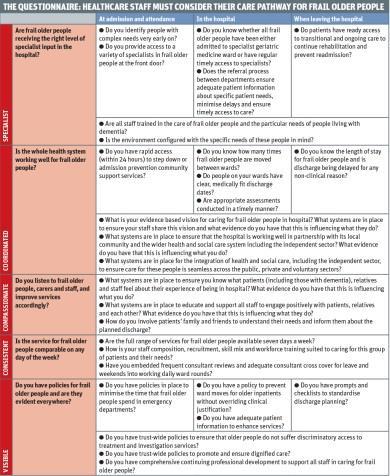HSJ’s landmark Commission on Hospital Care for Frail Older People is striving to transform health and social care for our older population

Nurse treating older person
Although health policy and political consensus has apparently united under the banner of “integration”, the health and social care system for frail older people shows significant signs of disintegration. It remains to be seen whether the commitment to deliver the significant organisational and relational changes - let alone the shift in funding - needed to bring about genuine integration will prove possible and durable in reality.
The HSJ commission’s main focus is on hospital care for frail older people.
As a starting principle we must not treat frail older people as a homogenous mass, doubting or ignoring their resilience and individuality. Nor should we make assumptions about their frailty and comorbidity based on their age alone. Equally, effective care must be able to deal with complex needs, as well as single specialty working.
- HSJ’s older people’s commission launches first “scoping report”
- Case study: The harsh reality and what should have happened to ensure the best care pathway
- VIDEO: Mrs Andrews’ failed care pathway
- Download the care pathway questionnaire
- Dame Julie Moore: why this matters
- HSJ launches Commission on Hospital Care for Frail Older People
- Meet the commissioners
- VIDEO: The experts on the commission
- Care of frail older people: in the commissioners’ words
- See more from our Comment section
- Sign up to our Comment newsletter
In frail older patients - as in any segment of the population we serve - one size does not fit all. All parts of the health system must help improve the care we offer frail older people, who for decades have paid the taxes that have built our current system.
A wealth of fine, well researched reports on improving care for frail older people already exist, and a lengthy reading list and source of references is on the commission website.
The project aims not to repeat that valuable work, but to distil, clarify and amplify the main points, updating it to today’s NHS with the academic rigour and frontline experience our commissioners offer.
Asking better questions

We aim to provide practical, reflective and easy to use tools for boards and staff to help encourage self-improvement, and to share the many existing examples of good patient-centred practice.
We invite HSJ readers to visit the commission’s website to watch films about the project and participate in order to help us compile and rate examples of good practice in hospital care for frail older people.
HSJ’s role as the leading health management and policy sector publication gives us a unique platform to ensure that the commission’s work will not be a one-off.
Our main report in November will be followed up in March 2015 with a final document highlighting key issues that the public may find helpful to inform them about the quality of care.
This document will include a set of questions to help the public ask more effectively how the healthcare system can improve their loved one’s care pathway.
‘All parts of the healthcare system must contribute to improving care for frail older people’
It will help them become more informed and involved, and encourage them to question MPs and local councillors in the run-up to the general election in May 2015.
Many older people presenting acutely to hospital in crisis do have acute needs that initially require these skills and facilities.
However, many only present this way because of an insufficient focus on proactive care and prevention, or because of a lack of credible, responsive services within their own home or other community setting. For others, once their acute episode is over they stay far too long in acute hospital settings not best suited to their needs and where they are exposed to risks such as immobility, infection, confusion or institutionalisation.
Intervention that can only be provided in acute hospital - for example, a hip fracture - is of course appropriate, but a meaningful improvement would be to see more advanced primary care delivered in community or residential settings.
In hospital older people generally say little about the clinical care; they expect this to be in place. Instead they have highlighted the importance of “see who I am”, “involve me” and “connect with me”.
These more relational aspects of care need to be emphasised in acute hospitals to counterbalance the damage of a “tick box” culture that has focused too much on measurement and not enough on meaning.
Righting our attitude

Our choice of language always matters. Referring to frail older people in hospital as “bed blockers” or “inappropriate admissions” shows an outdated and unwelcome tendency to blame patients for the failings of the system.
Pejorative language can easily feed through into bad attitudes and poor leadership behaviour. It is high time to stop this. These patients are the core business of hospitals and the healthcare system: we need people with the right attitudes at every level to meet the needs of this population.
Improving the care these people cannot be restricted to just the hospital process. The independent, not for profit and voluntary sectors are significant players in residential, nursing and social care settings: the care home sector has three-and-a-half times more beds than the NHS.
We know there are significant care gaps and variation in the quality of primary care support for people who are frail or have multiple age related long term conditions.
We know that health and wellbeing strategies are often insufficiently focused on the mature life course, even though at 65-years-old people can already expect to live another two decades on average, with these projections moving to 23 more years for men and 26 for women by 2030.
‘Too many older people remain in high cost acute beds not suited to their needs’
We also know from sources, such as the national audit of intermediate care, that we lack enough places and beds in both step up (admission prevention) “discharge to assess” or “step down” post discharge intermediate care, reablement and hospital at home/virtual ward services. There are also major unwarranted geographical variations in rates of admission or bed occupancy to hospital and in care home placement direct from hospital beds.
Some systems perform better than others. We have too many older people remaining in high cost acute beds not always suited to their needs for want of capacity, workforce and skills in other settings.
On the other hand, when they do have a genuine need to be in hospital, we need to make this environment “age proof”, “fit for purpose” and reflect the needs of those patients who are there.
It will require meaningful changes in funding distribution through the system and disinvestment is always hard. It will also require learning from good practice by one sector from another.
Supportive culture
According to the National Institute for Health Research, the prerequisites to creating a supportive culture are:
- A shared vision and goal
- Leadership from the top
- Enabling and involving staff at all levels of the organisation, especially clinical staff
- Investing sufficient time, resources and education in staff development
- Empowering people, especially those closest to the delivery of care
- Fostering positive relationships
- A focus on the patient experience
Bringing care home
Many commentators suggest we have too many hospital beds in England and that a focus on more care closer to home might solve this “problem” quickly.
Undoubtedly there are many patients in acute beds who could be cared for in other settings if the capacity existed and those admitted in crisis were better supported within primary and community services.
However, England has fewer hospital beds than all but one European country per head of the population. according to the Organisation for Economic Co-operation and Development. It has lost around 30 per cent of its beds in the past 20 years, yet emergency activity continues to rise.
Our hospitals run very “hot” - around 95 per cent occupancy - even though optimal occupancy for good patient flow is 85-90 per cent.
The evidence base for admission prevention delivered at pace is patchy, as is the evidence that care closer to home is cheaper than acute hospital. Finally, the notion that the payment by results tariff drives overactivity is dubious for these reasons:
- We have a national tariff but there is major variation in emergency activity even when adjusted for population health;
- The devolved nations that do not have a purchaser-provider split or tariff have proportionately more hospital activity than in England; and
- Finance directors do not admit or discharge acute patients, doctors do. Very few have even a basic understanding of the tariff and have no interest in looking after patients who no longer need to be in hospital, not least when hospitals are on daily red or black alert.
They said:
“Here is a radical suggestion: make hospitals good places for old people. Few national providers would make such a blatantly ageist inference that its ‘core business’ was too tricky to manage and propose to solve ‘the problem’ by ceasing to attempt to deal with it… The acute care of older people has progressed through being an inconvenience to being an anathema.”
Marion McMurdo, professor and head of ageing and health at the University of Dundee, wrote on BMJ.com
“It is absolute ‘la-la land’ to think we’re going to be in a situation any time soon where older people don’t keep piling through the doors of general hospitals. Hospitals are daily on black alert, opening any flat surface they can to put beds in, turning ambulances away… There’s not a load of convincing evidence yet of anywhere where focusing on prevention has actually led to reducing overall costs in the health and social care economy.”
Commissioner David Oliver, former DH national director of care for older people and president elect of the British Geriatric Society, said in an HSJ interview

One size does not fit all
The commission’s scoping report offers a checklist for executives, boards and clinicians to self-assess their organisations, and provides tips on how to achieve changes. More detailed checklists broken down by area of the hospital are available on the website, alongside other resources and an interactive survey powered by Clever Together to find out readers’ achievements made in key areas so far.
The commission aims to celebrate local good practice so please complete the survey.
One model of care will not fit everywhere; local solutions must be key to improvement. The quality of care we deliver to frail older people matters because delivering the best care we can is the right thing to do.
The mark of a civilised society is its treatment of its most vulnerable members. It matters because this is what our parents and grandparents and their friends will receive, and it sets the precedent for the care that we will enjoy when we are frail older people ourselves.
The questionnaire: Considering the care pathway for frail older people
The questionnaire is not just about asking questions and getting a “how to do it” fact sheet, but setting a trajectory for improvement; finding out the root causes of problems and remedying them in a culture of self-measurement to improve.
Which things make the most difference first? In terms of leadership and skills, it is about having the right people in place. Review your geriatricians, senior nurses and therapists: do they have the appropriate training?
Then you must review your range of services and review where frail older patients are cared for in your hospital and at what stage are they identified as frail older people: is it at admission? Once you have your baseline of data start addressing the issues identified and set improvement standards.
The commissioners are Dame Julie Moore, John Appleby, Julienne Meyer, John Myatt, David Oliver and Jenny Ritchie-Campbell
HSJ commission scoping report: Pave the way for better elderly care
- 1
 Currently reading
Currently readingHSJ commission scoping report: Pave the way for better elderly care
- 2
- 3
- 4































3 Readers' comments